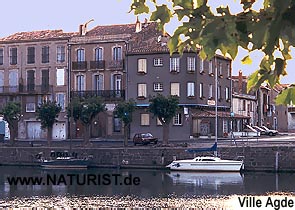|
|
|
|
|
|
|
 (c) 2006 Cap d'Agde nudist |
![]()
|
S�te,
as the most important port of the Languedoc-Roussilon region, is worth
a longer visit , despite having ugly industrial and harbour buildings
on its doorstep (not on the Agde side). Not without reason is S�te called
the "Venice of Languedoc". Houses fronting onto the Canal de S�te (the
best part of town, below St. Clair) are colourful and typically Mediterranean.
The atmosphere is particularly lively in this neighbourhood: S�te is the
largest French fishing port and second most important trading port on
the Mediterranean.
Especially
famous are the "ship battles" at the end of August. These have been celebrated
with much ceremony since 1666. A highlight of this traditional festival
is a battle between two large rowing boats. Each has a platform on which
a man stands with a lance. The objective is for each man to push his opponent
into the water. |
|
|
|
|
|
|
|
|
|